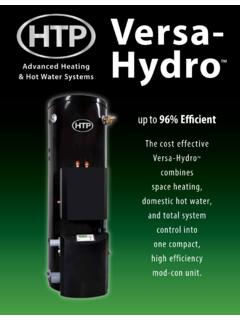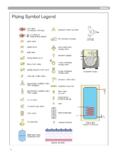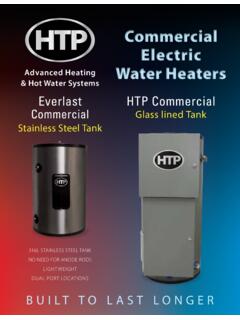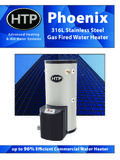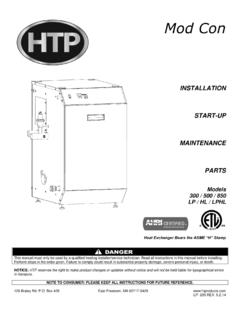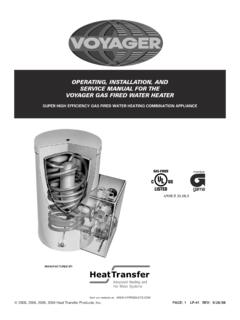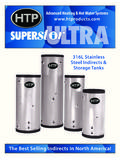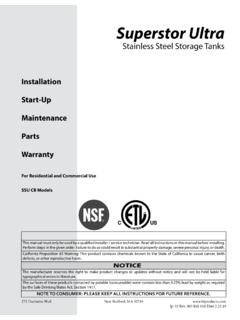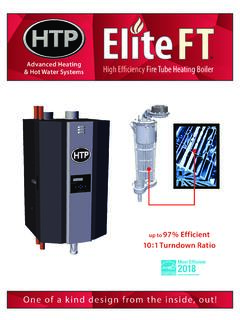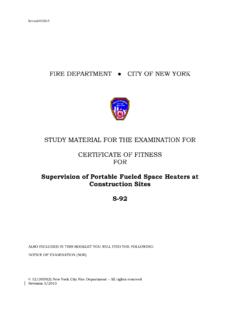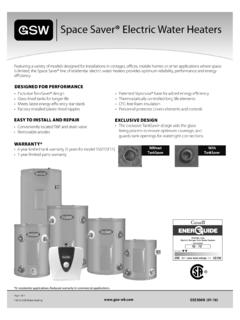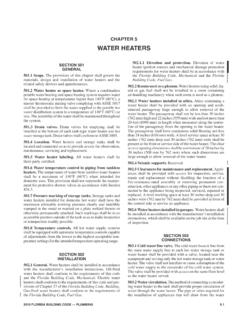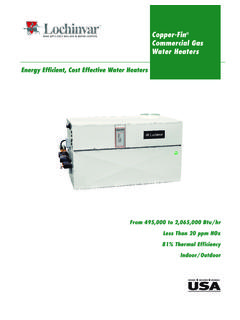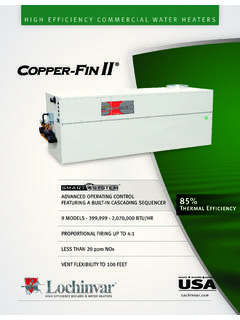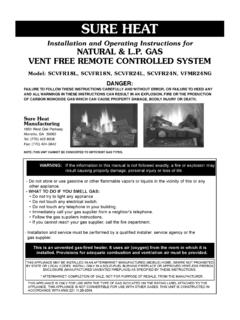Transcription of Condensing Storage Water Heaters - HTP - Water and …
1 Condensing Storage Water Heaters These Heaters are up to 96 percent efficient and typically easier to retrofit than tankless models by Jim Lunt I n my 30-plus years as a plumbing contractor, I've replaced countless Water Heaters . Our company, which works in the San Francisco Bay area, installs three basic kinds: conventional gas models, tankless models, and increas- ingly Condensing Storage Heaters . Customers who want to save energy nearly always ask for a tank less Water heater. That's no surprise . tank less Heaters have been getting a lot of media coverage and are the only efficient Heaters most people have heard of. In most cases, however, we recommend con- densing Storage Heaters to our replacement cus- tomers, because they are arguably more efficient than tankless models and when used to replace an existing heater frequently less expensive to install.
2 For homeowners, switching from a con- ventional heater to a Condensing model is not a big change. If they consume the same amount of hot Water as before, they'll have lower gas bills and run out of hot Water less often. Switching to a tankless heater, by contrast, requires some life- style adjustments: The homeowners will have to wait for the heater How They Work to produce hot Water and they won't be able to get it at very low In several respects, a Condensing Storage heater is like a con- flow rates (see Is a Tankless Heater Right for the Job?, next page). ventional model. Both burn gas, have exhaust flues, and store In this article, I'll discuss Condensing Storage Heaters and how hot Water in an insulated tank.
3 But a Condensing heater is much they're installed. Since natural gas is the primary fuel in our more efficient because of how heat is transferred to the Water . region, I'll be describing gas-fired models, many of which can be In a conventional heater, the fuel is burned in an open cham- field-converted for propane. ber, and hot combustion gas rises through a flue in the center JUNE 2009 l JLC l 1. Condensing Storage Water Heaters Is a Tankless Heater Right for the Job? W hen a customer asks us to replace a conventional Water heater with an on-demand isting flues cannot be reused in re- placement jobs. In areas where the temperature doesn't drop below or tankless model, we often freezing, it's sometimes possible to have to explain why a tankless unit eliminate the cost of the flue by in- may not be the right choice.
4 In stalling the heater outside. many cases we'll steer the home- owner toward a Condensing stor- Operation age heater instead. When a tankless heater's flow sen- Prominent among the selling sor detects a demand for hot Water , points of tankless Heaters are that it activates a vent fan and a burner they're more efficient than conven- that heats Water as it passes through tional Storage models and, within a heat exchanger. The burner will limits, able to produce an endless not be activated at flows less than stream of hot Water . However, the about gpm, and once activated, same can be said of condens- it takes 5 to 10 seconds for the flow ing Storage Heaters . The unique to go from cold to hot.
5 If the drain is advantage of tankless Heaters is open, that several seconds of flow that they're small enough to fit results in wasted Water . A recircula- where Storage models will not tion pump can reduce the amount (see Installing On-Demand Water of 77 F. However, advertised flow of waste, but most recirculation Heaters , 2/06). rates are frequently based on a 45 F systems are not directly compat- temperature rise and may not be ible with tankless Heaters . Efficiency Claims achievable something we point Cold- Water sandwich. Cold Water Much of a tankless heater's effi- out to customers. is introduced into the line every time ciency stems from the fact that it the burner turns off the so-called has no standby losses no gas- Installation Details cold- Water sandwich.
6 To eliminate consuming pilot light and no stored Although tankless units may cost this slug of cold Water , some plumb- Water losing heat through the walls less than Condensing Storage heat- ers may install a tempering tank of the tank. But its actual thermal ers, installation costs can be a lot a small electric Storage heater . efficiency (TE) is not all that high higher. This is particularly true in downstream from the tankless unit. typically around 82 percent. A num- replacement jobs. In my opinion, this is a poor solution ber of companies have introduced Gas line. Tankless Heaters have because it wastes energy and adds Condensing tankless Heaters with very large burners, so existing to the cost of the system.
7 TE ratings of up to 98 percent, but 1 /2 -inch gas lines will have to be I won't recommend these to clients replaced with 3/4 - or 1-inch line. Maintenance until they've been around for a while This could entail the last few feet of There is a filter screen on the supply and have proven to be reliable. line or everything all the way back side that prevents rust and sediment The endless stream. The output to the meter. from clogging the passages in the of a tankless heater is rated in gal- Flues. Most tankless Heaters re- heat exchanger. The screen should lons per minute (gpm) of Water quire expensive Type III stainless be cleaned and the heat exchanger at an assumed temperature rise steel vent pipe, which means ex- flushed and delimed annually.
8 JUNE 2009 l JLC l 2. Inside a Condensing Water Heater Air and gas in Hot- Water Auxiliary supply On/off switch supply for space heating loop Draft-inducing fan is Control panel behind this housing Combustion Pressure-relief chamber valve Combustion chamber Secondary heat exchanger Draft-inducing Control panel fan inside Cool combustion Secondary heat gases exit through flue at back of unit Auxiliary return exchanger Gas in for space heating loop Air intake Condensate exits to Flue connects here neutralizer and drain Condensate drain Condensate out Figure 1. A cutaway drawing of a Vertex heater (above) shows the combustion chamber and sec- ondary heat exchanger coil inside the tank. In the Heat exchanger Phoenix model at right, the combustion cham- Cold- Water inlet for solar thermal ber and secondary heat exchanger are located collectors in the upper part of the tank, with a second heat exchanger for a solar thermal collector below.
9 Of the tank. A lot of this heat is transferred to the Water see Making Sense of Gas Water -Heater Ratings, page in the Storage tank, but a good portion exits through the 7.) Standby losses are low because the Storage tanks are vent pipe and is wasted. covered with thick foam insulation plus these units all In a Condensing heater, a draft-inducing fan pushes have electronic ignition, so there is no standing pilot. air and fuel into a sealed combustion chamber inside the tank (see Figure 1). As the fuel burns, combustion gas Heating Capacity is exhausted through a secondary heat exchanger a Most people think of Storage Heaters in terms of tank and coiled steel tube submerged inside the tank.
10 The com- burner size as in a 40-gallon 40,000-Btu heater (see bustion chamber and heat exchanger have large surface chart, next page). The Btu rating is a measure of fuel in- areas to maximize heat transfer to the Water . So much put to the burner; output is measured in gallons of wa- heat is transferred that the combustion gases cool to the ter heated per hour to a particular temperature rise. The point where the Water vapor in the exhaust stream con- Condensing Heaters we install have an input range from denses, releasing its latent heat, which is also transferred 76,000 Btu all the way to 199,000 Btu. (By comparison, the to the stored Water . By the time the exhaust gas leaves typical tankless model we install is rated at 199,000 Btu.)
